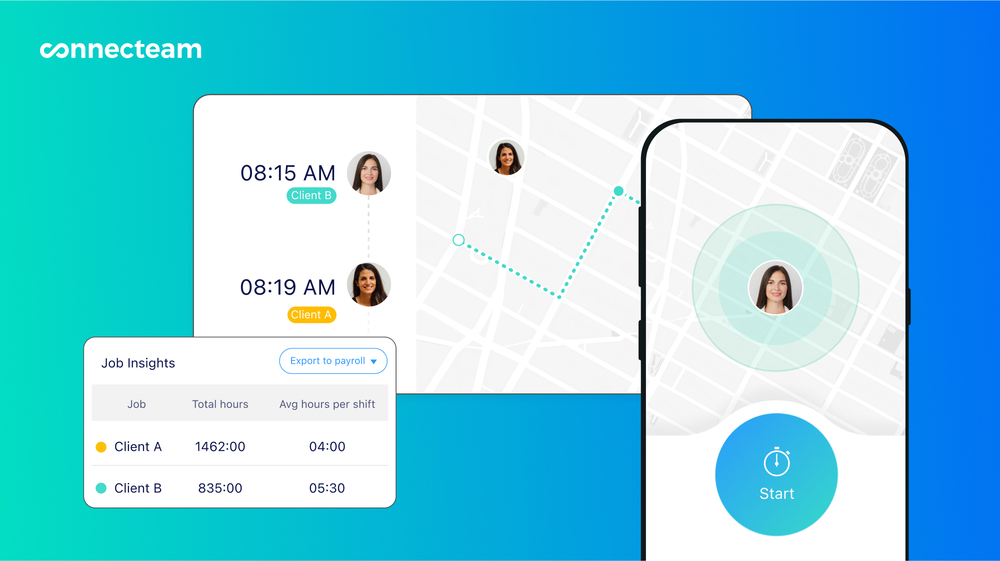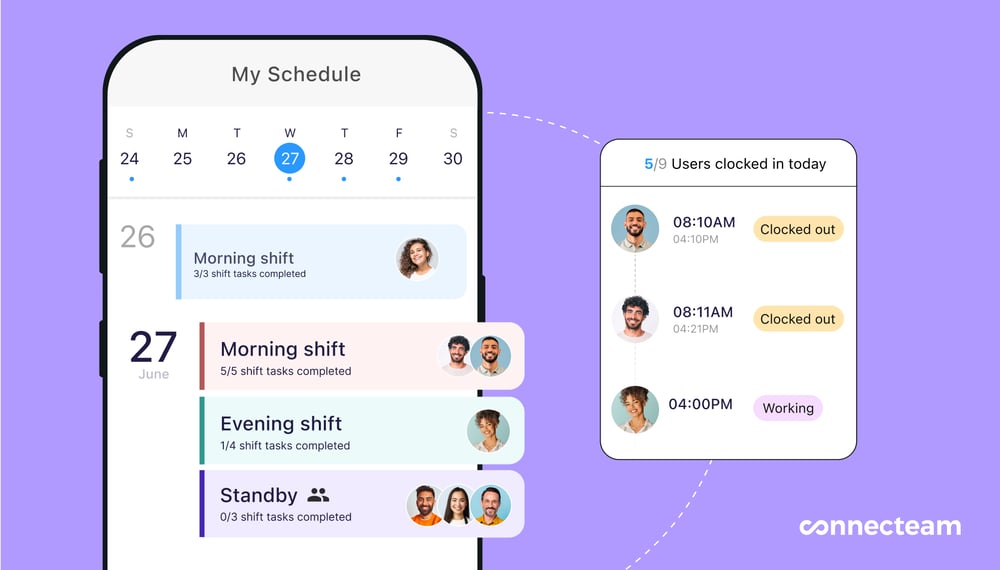Connecteam and Homebase are leading workforce management solutions. Connecteam shines in managing field and mobile teams, while Homebase is good for single-location businesses. Here’s how they stack up against each other.
A good workforce management platform helps you optimize team schedules, pay workers correctly, and boost your company’s operations. Connecteam and Homebase are both top-quality solutions, but they offer different benefits depending on your needs.
Since it’s not practical (or affordable) to set up an account, onboard users, and explore operations on both platforms, I’ve done all the testing for you. Below, I’ve put Connecteam vs. Homebase head-to-head so you can get it right from the start.
A note about our method: All product comparisons and verdicts in this guide are based on hands-on testing by our expert team. Every screenshot was taken from real use during our evaluation.
At a Glance: Quick Summary
Connecteam is a mobile-first work management platform designed for frontline and field businesses. It offers a comprehensive toolkit of features, including time tracking, smart scheduling, payroll integrations, in-app communication, task management, HR management, and more at a reasonable price. But it has limited third-party integrations, so it might not be best for large or complex businesses.
Homebase is a workforce management solution for hourly and shift-based businesses. It provides a wide range of features to support time tracking, scheduling, messaging, hiring, and more. Unfortunately, it only offers payroll as an add-on (even on the most expensive plans) and charges you per location, so costs could add up for multi-location businesses.
Pricing and Plans
Here’s a side-by-side comparison between Connecteam and Homebase’s pricing plans.
| Plan Type | Connecteam | Homebase |
| Free | Small Business Plan Free for up to 10 employees – All hubs (Operations, Communication, and HR & Skills) – All features | Basic Free for up to 1 location and 10 employees – Basic shift scheduling – Basic time tracking – Payroll as an add-on for a $39/monthly flat fee + $6/user/month – Point-of-sale integration |
| Next Tier | Basic (Operations) $29/month for up to 30 users $0.50/month for each additional user – GPS time clock – Basic scheduling – Unlimited tasks, forms, and checklists – Unlimited clients and projects – Payroll integrations | Essentials $24/location/month Unlimited employees Everything in Basic, plus: – Advanced time tracking – Advanced scheduling – Internal communicationPayroll as an add-on |
| Premium | Advanced (Operations) $49/month for up to 30 users $1.50/month for each additional user Everything in Basic, plus: – Advanced time tracking – Geofencing for up to 10 sites – Scheduling templates and repeat shifts – Conditional fields in forms – Advanced filters and bulk actions | Plus $56/location/month Unlimited employees Everything in Essentials, plus: – RecruitingTime off management – Payroll as an add-on – Custom roles and permissions |
| Ultimate | Expert (Operations) $99/month for up to 30 users $3/month for each additional user Everything in Advanced, plus: – Unlimited geofencing sites – Auto-scheduling – Unlimited shift attachments – Up to 12 different schedulesAPI access | All-in-one $96/location/month Unlimited employees Everything in Plus, and: – Team onboarding – Labor cost support – HR & compliance tools – Payroll as an add-on |
| Enterprise | Enterprise (Operations) Contact Connecteam for pricing Everything in Expert, plus: – Unlimited schedules – Single sign-on (SSO) – 2-factor authentication (2FA) – Biometric app lockIncreased API rate limits – Dedicated customer success manager | N/A |
| *All prices show the monthly cost when billed annually as of July 2025. | ||
Connecteam uses a hub model for its pricing. The above prices are for its Operations hub. However, you’ll find the same tiers and pricing for the Communication hub and the HR & Skills hub. I like how you can pay just for the set of features you need, but I would have preferred to see time off management and scheduling in the same hub, as it helps to view workers’ PTO when assigning shifts.
Still, access to all hubs costs less than many competitors. What impressed me most, however, is that the free small business plan provides access to all hubs and features, which isn’t common practice, in my experience.
Homebase’s location-based pricing model is good for businesses operating from one or just a few locations, and lets you grow your team without worrying about costs. That said, think twice if you plan to add more locations, as costs can add up quickly.
Homebase offers a free plan for small businesses, but with limited features. I also thought it was strange that payroll is only available as an add-on, even on the so-called “All-in-one” plan, so real costs are actually much higher.
My advice? Connecteam is a strong choice if you’re looking for an affordable all-in-one work management platform and a no-brainer for small businesses with fewer than 10 users. Homebase is great for small to medium businesses, as long as they’re operating from a single or just a few locations.
Pros and Cons
I’ve summed up the pros and cons of both platforms.
Connecteam pros ✅
- Full-featured and user-friendly mobile app—perfect for teams on the move.
- Very reasonably priced, plus an all-access, free-forever small business plan for teams with fewer than 10 users.
Connecteam cons ❌
- Doesn’t offer automatic mileage tracking, although you can do this manually with custom forms.
- Limited in the number of native integrations currently on offer.
Homebase pros ✅
- Reasonably priced for large teams operating from a single location.
- Employees can cash out up to $400 in early wages with no risk to the company.
Homebase cons ❌
- Payroll must be purchased separately, which can increase costs significantly.
- Limited in privacy and security features—no ISO, SOC 2, GDPR, or HIPAA certifications.
Use Cases
Both platforms can help you better manage your workforce, but they shine in slightly different areas.
Connecteam is best for:
- Accurate time tracking and verification: Workers can clock in and out with a single touch from any device, making it easy to track time from work sites or even on the move. You can also make manual entries and adjustments, set geofences, and track workers’ live GPS locations to ensure accuracy and prevent time theft.
- All-in-one work management: In addition to scheduling and time tracking, Connecteam offers feature-rich task management tools and an integrated in-app chat, so you can tell workers exactly what to do in their jobs, rather than just when and where they need to show up.
Homebase is best for:
- HR advisory: Homebase’s All-in-one plan offers access to HR experts who can answer employee relations, HR, and compliance questions, and even help with reviewing your HR policies and creating a custom handbook. This is ideal for businesses with complex or cross-jurisdiction HR and compliance needs.
- Hiring new employees: With Homebase’s higher-tier plans, you can post jobs to multiple job boards, track applicants, and send offer letters or new joiner paperwork to your candidates. Having a built-in applicant tracking system isn’t a must, but it works well if you want a combined workforce management and recruiting platform.
Side-by-Side Feature Overview
Connecteam and Homebase have several overlapping features, and a few that are unique to each. Let’s look at how the two platforms measure up against each other.
Time and location tracking – Winner: Connecteam

Both platforms let workers clock in and out of their shifts and rest breaks from any device, including desktops, laptops, tablets, and shared kiosks. Users can also manually track time on both.
Connecteam’s employee time clock lets you set geofences—virtual boundaries around work sites—to prevent workers from clocking in unless they’re at work. I was also impressed by the ability to activate auto–clock-out, which stops time tracking when workers leave geofences.
What’s more, you can also set up overtime rules and alerts, capture workers’ GPS locations and clock in and clock out, and see live GPS locations through its breadcrumbs feature. This is an excellent way to keep workers accountable and reduce time theft.
Homebase gives workers one more way to punch in and out—through POS (point-of-sales) systems. Similar to Connecteam, you can set up geofences and overtime rules, but Homebase also lets you mandate photo verification when workers clock in and out, which I think is a clever way to reduce instances of buddy punching (when one worker clocks in for another).
That said, while Homebase captures locations on clocking in and out, it doesn’t offer live GPS location tracking for teams on the move, so I think Connecteam’s time tracker is slightly more versatile.
Online timesheets and payroll – Winner: Homebase

Both apps automatically use workers’ time logs, PTO data, and custom pay rates to generate ready-to-use timesheets for payroll.
In Connecteam, you can view timesheets along with any alerts for missed or duplicate entries in your dashboard, edit as needed, and approve these before exporting for payroll with a single click. I was impressed that Connecteam integrates with multiple popular payroll platforms, like Gusto, Xero, ADP, Paychex, and QuickBooks, so workers can get paid quickly and without manual mistakes or hiccups.
The big plus point for Homebase is that, in addition to payroll integrations, it offers its own built-in payroll system for an additional fee. Homebase handles payments, taxes, W2 and 1099 filings, and even lets workers access up to $400 in early wages with no risk to your company—a great way to support their financial well-being. Despite its noticeable price tag, I think having this option puts it just a notch above Connecteam’s offering.
Shift scheduling – Winner: Connecteam
Both Connecteam and Homebase shine in their scheduling features. You can build and assign shifts from scratch using the drag-and-drop functionality, recurring shifts, shift templates, and the option to copy schedules.
I was also impressed by both platforms’ smart scheduling tools, which automatically assign shifts to employees based on their preferences, skills, locations, and availability. Employees can pick from open shifts and swap/trade shifts on both systems, which I like as it empowers them to make their own choices.
Homebase’s differentiator is that its auto-scheduler also accounts for labor budgets and sales forecasts when assigning shifts, which is pretty cool, in my opinion.
That said, we did encounter a glitch when testing Homebase’s scheduler. We logged in as an employee and set a recurring availability preference starting from a future date. Unfortunately, when we tested this function as an admin/manager, the preference wasn’t recurring and took effect immediately instead of the future date.
Even if Homebase fixes this glitch, Connecteam’s employee scheduler is still the winner for me because of the ability to add tasks, subtasks, custom forms, and checklists directly into shifts. I think this is absolutely critical for helping employees understand what’s expected of them in their jobs, not just where they need to be.

Time off management – Winner: Tie
Connecteam and Homebase offer powerful time off management tools. You can create custom leave types, each with its own permitted time off, accrual rules, and carryover settings.
Employees can view their allowances and submit time off requests from their apps, while you can view their balances and respond to requests directly from your own admin account on either platform. Once approved, both Connecteam and Homebase’s smart schedulers account for leave when assigning jobs.
Here’s what I didn’t like very much: With Connecteam, time off features are in the HR hub, so if you want access to time tracking, scheduling, and time off management, you need to sign up for two hubs (although this is still relatively inexpensive and you get access to more HR tools, too). With Homebase as well, time off features are locked behind the most expensive plans.
Task management and communication – Winner: Connecteam

While task management and communication aren’t mandatory in time tracking and scheduling apps, I think they’re critical for platforms advertised as all-in-one workforce management solutions. Both Connecteam and Homebase offer these tools, but with variations.
Connecteam’s employee task tracking tools let you create and assign tasks, subtasks, and checklists to employees. You can add deadlines and attach notes, files, and even images so employees know what to do, how to do it, and when to do it.
Employees are notified when tasks are assigned. They can mark them as complete once done, and you can even mandate e-signatures on tasks and checklists, and track progress in real time from your dashboard. This way, you can rest assured that a job is complete.
On communication, Connecteam’s online team chat lets you message workers in 1-to-1 or group settings. It supports rich-text formatting, emojis, and multi-media attachments such as images, videos, audio notes, and PDFs—I find this highly impressive. There’s also a newsfeed for company-wide updates, surveys, and polls to gather employee feedback so they can always feel valued and involved in company decisions.
Homebase’s offering is more basic on both fronts. You can use its messenger to send private and group messages and post announcements. But it doesn’t support attachments or emojis, and we noticed some glitches where messages sent on a mobile app didn’t sync with the web browser until refreshed.
There’s also a task management feature, but it’s a paid add-on for $13/month/location, and as such, wasn’t accessible for hands-on testing.
HR and compliance – Winner: Tie

Connecteam and Homebase both offer employee document management, so you can store important documents, employee certifications, company licenses, and more, and even set expiry dates to ensure you review them on time.
Homebase offers access to hiring tools and certified HR pros who can provide advice, answer questions, and help you create your handbook. It also files compliance paperwork for payroll. These are all excellent features, but are only available on expensive plans or as add-ons, respectively.
What Connecteam lacks in expert HR guidance, it makes up for in the breadth of HR features it provides. You can build custom training modules, including compliance, health and safety, and other courses from scratch and roll these out to employees. Connecteam also offers custom forms and checklists to boost compliance on the job, as well as additional HR tools like an org chart builder, and digital recognition and rewards to improve your people strategy.
Third-party integrations – Winner: Homebase
Connecteam’s big plus is that it integrates with several popular payroll providers, including QuickBooks, Gusto, ADP, Xero, and Paychex, giving you a wide range of providers and budgets to work with. It also offers a few niche and unique integrations, such as with Wix’s booking system and Lightspeed’s POS. While Connecteam’s integration list isn’t long, it connects with Zapier to automate workflows between apps, filling most of the gaps.
Homebase offers a much wider range of native integrations across payroll, job boards, POS systems, and more. Popular integrations include ADP, Gusto, Square, Shopify, Clover, Toast, and others. While it doesn’t offer API access via Zapier, I found its integrations to be more impressive than Connecteam’s.
Reporting – Winner: Tie

Connecteam and Homebase treat reporting and analytics in very different ways.
Connecteam gives you detailed reports around employee time and attendance, including everything from hours worked to rest breaks and overtime information. It also provides a variety of analytics across features, including training completion histories, task completion, and incident reports.
What really stood out to me, though, was the engagement analytics. You can see how employees interact with newsfeed posts and how they’ve responded to surveys and polls, which is useful in boosting employee engagement and supporting workers where they need it.
Homebase offers a fixed set of standard reports, including hours worked, labor costs, shift feedback, and attendance. I like that you can get granular in some of these—for instance, comparing real vs. scheduled hours or viewing labor cost by department or role, which is key to good decision-making. But there are limits. You can’t filter by custom time ranges, there’s no option to build custom reports, and only a few reports can be exported or printed.
User Ratings
Connecteam and Homebase have largely positive reviews from users, but Connecteam’s rating is slightly higher on G2.
Connecteam
Homebase
Security & Compliance
Here’s how the two platforms’ security features compare.
| Feature | Connecteam | Homebase |
| Data Encryption | ✅ | ✅ |
| 2-Factor Authentication (2FA) | ✅ | ✅ |
| ISO Certifications | ✅ ISO 27001, SOC 2 Type 2 | ❌ |
| Access-Based Controls | ✅ | ✅ |
| GDPR Compliance | ✅ | ❌ |
| HIPAA Compliance | ✅ | ❌ |
There’s no doubt that Connecteam comes out on top in privacy and security, as far as I’m concerned. Connecteam follows strict data protection standards with ISO 27001 and SOC Type 2 certifications—the gold standard in security. You can also set up 2FA, role-based access controls, and single sign-on (SSO), which is great for larger teams.
Importantly, Connecteam is compliant with Europe’s GDPR regulations and HIPAA regulations in the US—a bonus for any regulated or non-regulated company that deals with sensitive customer data.
Homebase also offers several security features, including 2FA and role-based access. Plus, it conducts regular security audits. However, it doesn’t have any ISO or SOC 2 certifications and doesn’t state GDPR or HIPAA compliance. I wouldn’t recommend it for regulated industries like healthcare or finance.
Setup and Onboarding

Connecteam makes it easy to get started. You can create your account and invite employees in a few straightforward steps. The platform walks you through your initial setup with a checklist, which is a great way to ensure you don’t miss anything important. You can use ready-made templates to start creating schedules right away and watch handy training videos to learn how to use different features. The mobile app was also very user-friendly and didn’t feel cluttered at all.
Homebase also felt equally easy to set up. I was a fan of the modern and intuitive interface and liked that there were prompts to help you add team members, assign roles, and start scheduling. Again, pre-built templates and video tutorials offered additional support. Overall, both platforms were easy to use, even for those who may be less tech-savvy.
Support and Customer Service
Let’s explore what Connecteam and Homebase’s customer support offering looks like.
| Support | Connecteam | Homebase |
| Live Chat | ✅ 24/7 | ✅ 8 am–7 pm CST, Monday–Friday |
| Phone | ❌ | ✅8 am–7 pm CST, Monday–Friday |
| Request Form / Email | ✅ | ✅ |
| Help Center | ✅ | ✅ |
| Onboarding Support | ✅ (paid via Connecteam Pros) | ❌ |
| Personal Customer Success Manager | ✅ (on Enterprise plan) | ❌ |
While both platforms offer email and chat support and have fantastic help centers, there are some obvious differences in the level of service. Homebase gets a point for providing phone support, whereas Connecteam doesn’t. That said, Connecteam’s live chat is available round-the-clock, while Homebase’s phone and chat support are limited to weekdays between 8 am and 7 pm CST, which isn’t friendly for all time zones.
Moreover, Connecteam offers a dedicated customer success manager for businesses on the Enterprise plan or the option to use “Connecteam Pros”—a service that helps companies on any plan with onboarding, setup, and initial implementation. While this is a paid service, I love that employers have the option to use it when they’re looking to make a quick and effective switch, adding hubs, or scaling their business.
🏆 Who Wins: Connecteam or Homebase?
| Choose Connecteam if you… | Choose Homebase if you… |
| Want a mobile-first platform with everything from time tracking and scheduling to task tracking, HR management, training, and a feature-rich chat. | Need a platform that offers in-house payroll, tax, and compliance services. |
| Are a small business with fewer than 10 employees and looking for a plan that offers all features for free, forever. | Are a small- to medium-sized business operating from a single location or just a few locations. |
| Need an app with a user-friendly interface and easy setup for teams that are less tech-savvy. | Would like to provide your employees with cash advances of up to $400 to reduce financial stress and boost morale. |
| Require strong security and privacy measures, including HIPAA or GDPR compliance. | Require support from a certified HR pro. |
| Learn more about Connecteam | Read our in-depth Homebase review |
Our take
Both Connecteam and Homebase are solid options for managing your frontline or shift-based teams.
So, which platform would I recommend? It depends on your goals and budget. If you’re a non-desk or mobile team looking for an affordable all-in-one workforce management solution that also provides comprehensive task management, communication, and training features, Connecteam is the way to go.
For small single-location teams who care less about advanced communication or task management tools but would like to add hiring, a broader set of integrations, or expert HR support to the mix, consider Homebase.
FAQs
Is Connecteam worth it?
Yes. Connecteam uses a price-per-hub model, starting at $29/month for up to 30 users for each hub you want access to—Operations, Communication, or HR. Even if you opted for all 3, you could pay just $87/month for up to 30 users to access a broad range of features.
Is Connecteam actually free?
Yes. Connecteam’s small business plan is free for businesses with fewer than 10 users. You can access all of Connecteam’s features—no strings attached.
Is Homebase actually free?
Yes. Homebase offers a free small business plan for up to 10 employees in a single location, but the features on this plan are fairly limited.
Does Connecteam have a free trial?
Yes, Connecteam offers a free 14-day trial before you upgrade to a paid plan.

